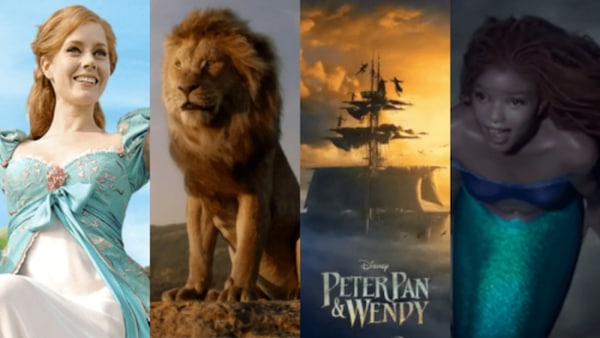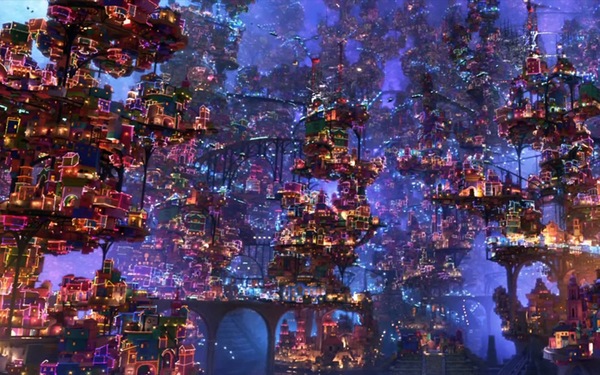A Whole New World by Disney

- Saaya Vaidya
Film Companion
Last Updated: 01.54 PM, Sep 15, 2022

From pumpkins that turn into carriages to dancing skeletons in the afterlife, there’s a dazzling variety of worlds that make up the Disney universe. Here’s a look at what goes into creating the Disney magic and exploring three very different imaginary realms.
The afterlife
In Coco (2017), directed by Lee Unkrich and Adrian Molina, the Land of the Dead seduces you with its vibrance and then horrifies you with its rules — souls (portrayed as skeletons) can only live there as long as they are remembered in the Land of the Living, after which they face a final death. But so long as they are remembered, the Land of the Dead is a good place. With towers built on Aztec and Mayan pyramids, Spanish colonial-era buildings, Mexican Revolution and Victorian-era buildings, topped with 20th-century architecture, the Land of the Dead is a place where one keeps building on the past. Production designer Harley Jessup was inspired by Guanajuato city in central Mexico. “It’s a city of terraced architecture that is going up steep hillsides — very brightly colored and layered. There’s a network of tunnels at the base, and then layers of architecture that go up the hillside,” he said. Mexican artist Jose Guadalupe Posada’s engravings, especially La Catrina, also inspired the world of Coco. Jessup said the architecture represented a well-researched and “layered history of Mexico”. Another inspiration was the Aztec belief that in the Land of the Dead, one should have a Xolo dog (hairless dog) to help them through the challenges they’d face along the way. This is why the protagonist is accompanied by Dante the dog.
While Coco’s afterlife is based on beliefs in Mexican culture, the Great Beyond in Pete Docter’s Soul (2020) appears to have metaphysical connotations. Souls find themselves on a bridge leading to an enormous, white light, which is a portal that opens into the Great Beyond. It is the space between the spiritual and the material world and is supervised by mentor souls. The film’s team spoke to rabbis, priests, and Buddhists to gain perspective on both what souls are and how the afterlife should look. “Most people said the souls are ethereal. They’re non-physical, they’re invisible, not very helpful in terms of hints on how to design things,” Docter said. And so the souls were portrayed as “foggy” and “vaporous”. Character designer Albert Lozano had suggested they make an “icon” of the character but without using facial features as a guide. Instead, they focussed on the “distilled down, simplified, absolute reductionist” details. Soul was also deeply inspired by modernist Nordic sculptures. Since Joe Gardner, the protagonist, is a Jazz musician, the animators turned to album covers of the Fifties and the Sixties for inspiration.

Under the sea
Since the aquatic world is already mesmerizing enough to be fantastical, the goal of Andrew Stanton’s Finding Nemo (2003) was to“make things believable, not realistic.” The animators watched Disney classics with underwater scenes such as Pinocchio and The Little Mermaid but kept returning to Bambi because of how effortlessly the animals’ motor skills were depicted. They began thinking of Finding Nemo as “Bambi underwater”. The animators went diving in Monterey and Hawaii, observed Pixar’s 25-gallon fish tank, and even visited Sydney Harbour. They had lectures with ichthyologist Adam Summers, who had to answer questions like where a fish’s eyebrows would be, and the difference between the flapper and rower fish. “I found that a lot of the gestures humans make could be boiled down to eye and face movements. I would look at my own face in the mirror and imagine I had a tail on the back of it,” said directing animator Alan Barillaro.
Under the supervision of technical director Owen Jacob, six teams worked on the different environments seen in Finding Nemo. There was the Ocean Unit (responsible for the school of moon fish and the jellyfish forest), the Reef Unit, the Sharks/Sydney Unit (that dealt with the shots inside the whale and in the Harbour), the Tank Unit (responsible for elements of the fish tank), Schooling/Flocking team (which assembled important elements of the turtle-drive segment) and the Character Unit (which constructed the appearance and movements of 120 aquatic, bird and human characters).

More than 15 years later, in Enrico Casarosa’s Luca (2021), the sea monsters in the film have evolved to become human beings when on land. The transformation from fish scales to human skin was learnt from the technology of blending skin and skeleton in Coco. As far as the creation of sea monsters is concerned, they were inspired by Renaissance maps from the 1500s and old Italian sculptures that the animators came across when they went to Italy for pre-production research. The animators also studied the movements of marine iguanas for reference.
The speed from Looney Tunes and stop-motion from Shaun the Sheep were incorporated into the film. Casarosa’s fondness for Hayao Miyazaki’s work, especially Future Boy Conan (1978) and The Castle of Cagliostro (1979) inspired 2D concept art that was later translated into 3D. Luca is set in the fictional town of Porto Rosso, based on five coastal towns in the Cinque Terre region of Italy, and the name is also a nod to Miyazaki’s Porco Rosso (1992). Luca’s story is a reflection of Casarosa’s childhood in Genoa, Italy, that he spent with his best friend Alberto.

Buildings and Homes
Carl Fredricksen’s home from UP (2009) embodies the life he spent with his late wife, Ellie. When the film had to show his home floating away with the help of 10,297 balloons, it was tricky to figure out and animate the place where the house would settle. Thus, the animators had to go on their own journey. The Pixar team went on a research trip to Venezuela, which was a reference to design Paradise Falls, the destination where Carl intends to dock his home and honour Ellie’s dream. The home itself was thought of as a character, and the team visited old Oakland and Berkeley neighbourhoods, looking for the perfect combination of warmth and familiarity, but with a hint of gloom. “We were trying to make Carl’s house look like your grandparents’ house smelled,” said producer Jonas Rivera. He also pointed out that when Ellie is alive, the colour palette is heavily saturated. After she passes away, de-saturated shades dominate the screen. The colourful balloons, however, are an ode to the memory of Ellie.
Perhaps one of the most famous homes in the Disney universe is in Beauty and the Beast (1991), where the Beast’s castle is filled with animated, magical furniture. Lumiere the candelabra, Cogsworth the clock, Mrs Potts the teapot, and her son Chip, the teacup, might be furniture items and crockery, but they’re the ones who bring humanity and warmth to the film.

They help the audience navigate the story, providing commentary and relief. Creating motion for these objects was extremely difficult for the animators, who had to figure out ways by which the objects could mimic body movements and be infused with distinctive personalities. For instance, director Gary Trousdale described Lumiere as a man whose shoelaces are tied together. Cogsworth became a clock because as a human, he was prompt and loved monotony. Since a clock is made of wood, metal and glass, they questioned how he would move, and if he was flexible at all. Will Finn, who supervised the animation for Cogsworth, said characters like these were made of a material he called ‘Disneyite’ — it has the texture of a substance it is supposed to be made of but would be immensely pliable. There’s a scene where Mrs Potts needed to jump from the fireplace to scold the Beast. To prevent her from shattering, the animators drew a pillow on the ground!
Another magical Disney home is Casita in Encanto (2021). Casita is the residence of the Madrigal family and is described by director Byron Howard as the “family dog” who adds excitement but also a sense of foreboding. Set in Colombia, the film uses magical realism (a style of writing made famous by Colombian author Gabriel Garcia Marquez) and draws upon the colonial architecture of Barichara, the windows and doors in Salento, and the colourful buildings of Guatapé and Cartagena.

The animators had to design several multi-purpose rooms where tiles, floorboards and windows came to life to manipulate situations and events. The courtyard staircase moved as though it had a hydraulic-like system. “We didn’t want to warp the tiles, so a mechanism was built. The directors said imagine if we had to build this with a stage prop and we wanted this to really work,” said VFX supervisor Scott Kersavage. And so, the tiles were made to flip and rotate to construct a smooth surface. Another challenge was to figure out how doors and other wooden surfaces would crack, and how the grooves could be made deeper. “This led to enhancements from effects and rendering to use [a higher-res] algorithm [for the fracturing] and a lighter weight version of topology everywhere else. That was a new advancement. In the past, we had to up-res full geometry everywhere for the surface that we’re cracking and substitute things into it. That was a huge lift for us,” said Kersavage.
